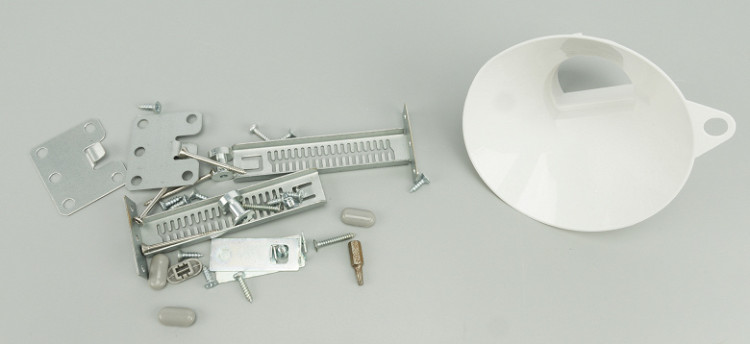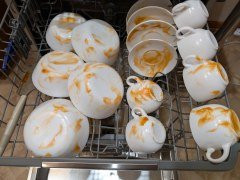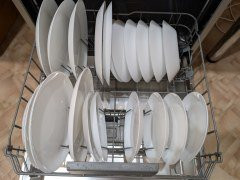Built-in dishwashers are the workhorses of our kitchen: no frills, just functionality.
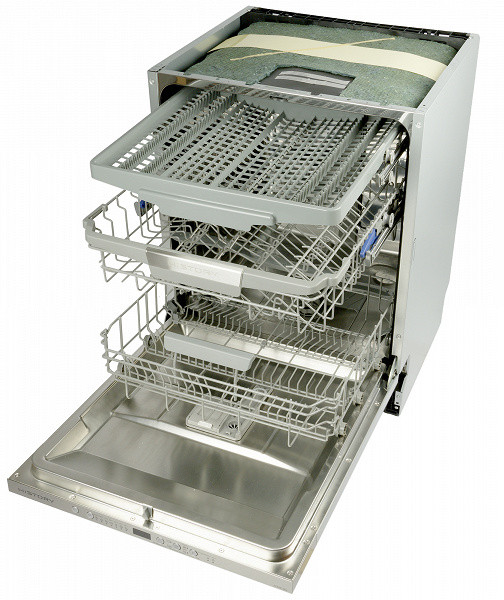
Today we are testing the History DI 67BC MSS with drum light, half load mode and open door drying. Let's see how it holds up to our tests.
Characteristics
| Manufacturer | History |
|---|---|
| Model | DI 67BC MSS |
| Type | Full size integrated dishwasher |
| Country of origin | China |
| Guarantee | 3 years |
| Service life * | 10 years |
| Number of sets of dishes | 14 |
| Number of baskets | 3 |
| Control | electronic |
| Indication | selected program, washing time, lack of salt, lack of rinse aid |
| Number of programs | 7 |
| Programs | Auto, Intensive, Standard, Eco, Delicate, 90 minutes, Fast |
| Delayed start | 1-24 hours |
| Adjusting the rinse aid dosage | There is |
| Adjusting salt consumption | There is |
| Camera lighting | There is |
| Top sprinkler | There is |
| Leakage protection | AquaStop |
| Half load mode | There is |
| Automatic door opening | There is |
| Connection power | 2.1 kW |
| Drying efficiency class | A |
| Wash class | A |
| Energy efficiency class | A+++ |
| Annual electricity consumption | 241 kWh |
| Energy consumption in standard cycle | 0.849 kWh |
| Weight | 37.5 kg |
| Dimensions for installation (W×H×D) | 600×820×580 mm |
| Length of network cable | 1.5 m |
* Contrary to popular belief, this is not a period after which the device will necessarily break down. However, after this period, the manufacturer ceases to bear any responsibility for its functionality and has the right to refuse to repair it, even for a fee.
Equipment
The front of the cardboard box in which the machine was delivered contains the manufacturer's logo, the address of the official website, and a schematic image of the dishwasher. There is no other important information on the packaging, which is standard practice for manufacturers of large household appliances.

You can make sure that you have received the right model by checking the model index indicated on a small white sticker. It also contains service information about the device: a barcode with a serial number and other manufacturer data.
Opening the box, we found a dishwasher, and inside it, a bag with accessories: a funnel for salt, fasteners for installation, and documentation.
The set of fasteners includes everything you need to install the device: universal fasteners, hooks for attaching furniture fronts, self-tapping screws, plugs, and even a hex bit, although a layer of corrosion is visible on it.
At first glance
The History DI 67BC MSS dishwasher belongs to the category of fully built-in devices: after installation, it will be completely covered by the walls and facade of the kitchen unit. The machine body is simple and functional, without any decorative elements: a metal door, steel side panels and a noise-insulating layer on top.
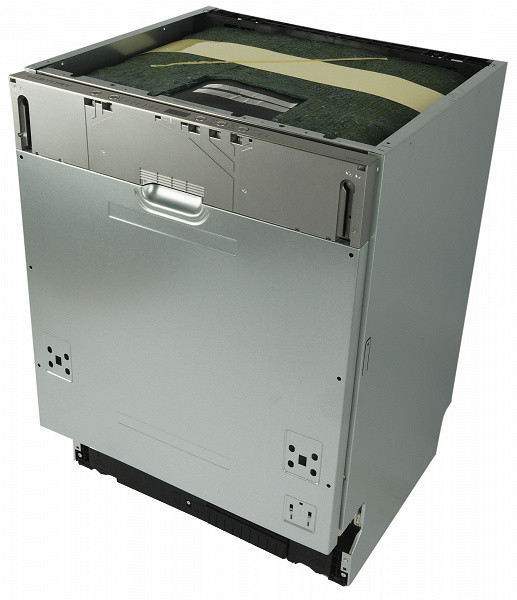
This model is equipped with three baskets: the lower one is designed for large dishes such as pots, pans and trays; the middle one is for dessert plates, cups, saucers and other fragile items; the upper one is for cutlery.
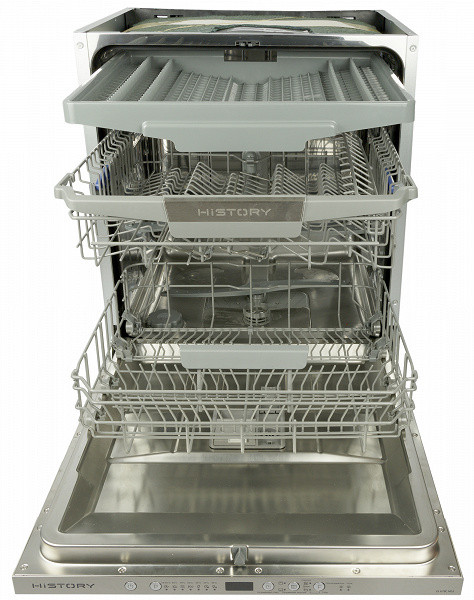
The upper and middle ones rest on telescopic guides. The lower one moves on eight rollers along the projections of the tank and the door.

The lower basket is made according to the classic scheme: it is equipped with two rows of guides for plates. The front row is fixed, and the back one can be folded to more conveniently place large dishes, such as large pots.
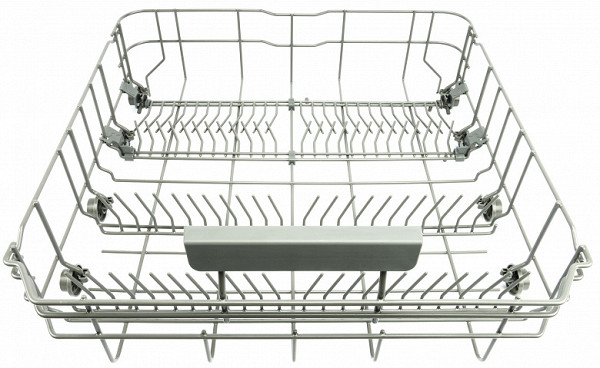
The middle basket has folding metal cup holders and glass stems on the right side wall and in the central part.

A sprinkler with slightly curved blades rotates under the shelf.
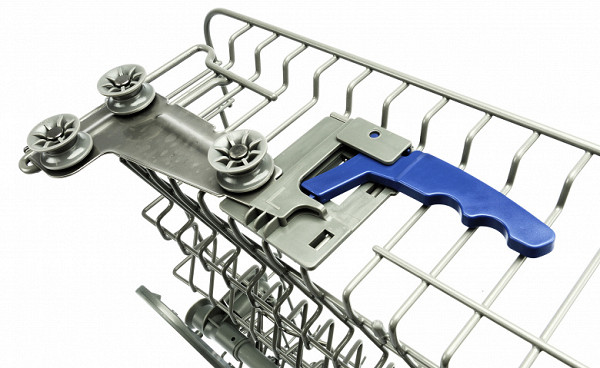
The middle shelf has two positions, but you don’t need to remove it to rearrange it: just pull the blue plastic lever, put the basket in the desired position and release the lock.

The cutlery shelf is designed so that forks, spoons and knives are placed in two rows on the sides. In the center there is a recess for kitchen knives, spatulas and ladles, which should be laid lengthwise.
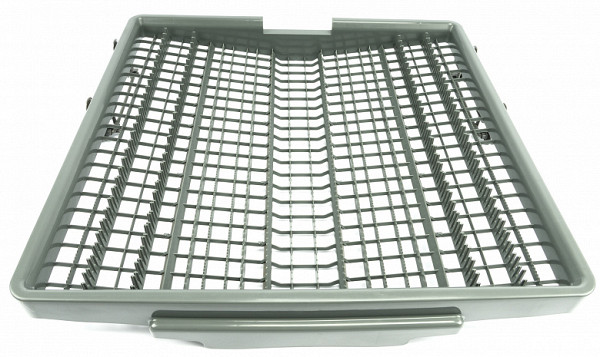
The tank tray, like the entire container, is made of stainless steel. Here you can see a slightly curved sprinkler, a softener neck into which special salt is poured, and a filter cover.
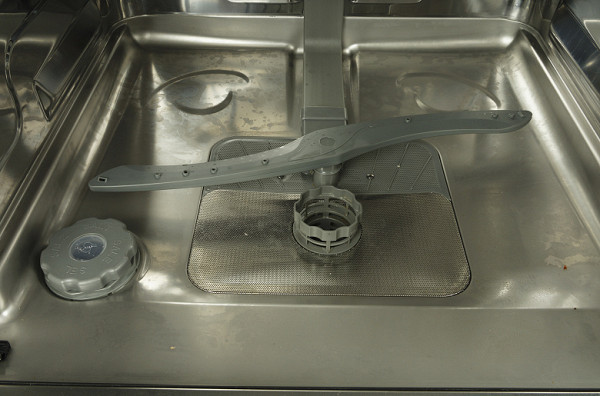
The filter element is located behind a rectangular steel plate with fine perforation. It is made in the form of a familiar design: a nylon mesh on a plastic frame.
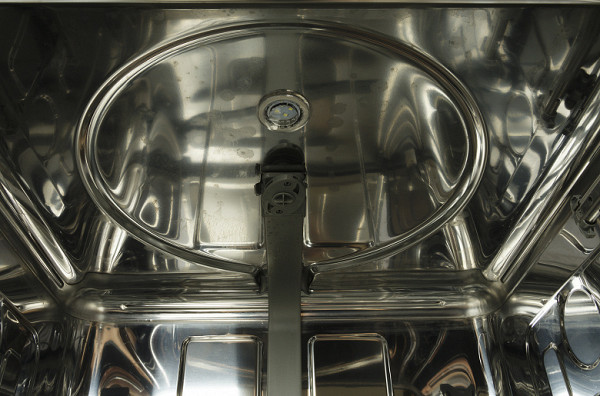
The third spray nozzle is mounted on the ceiling of the tank: it ensures the cleanliness of the cutlery on the top shelf. Next to it is an LED light.

The detergent drawer is divided into two parts: the larger part with a pull-out flap is for powder and tablets, while the smaller compartment has a hinged lid that holds the rinse aid reservoir.
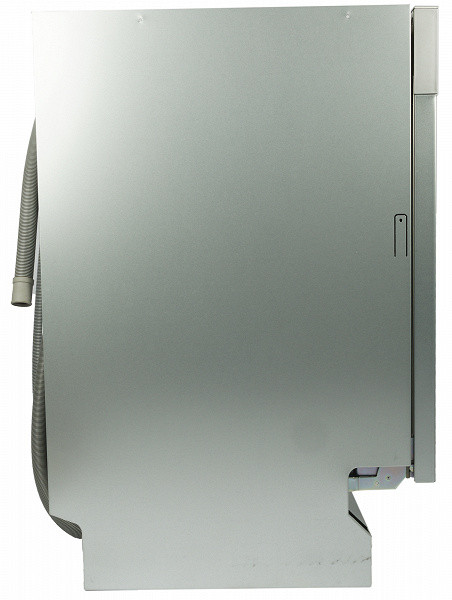
The side walls of the device are made of unpainted steel: they will be completely hidden when installed in kitchen furniture.
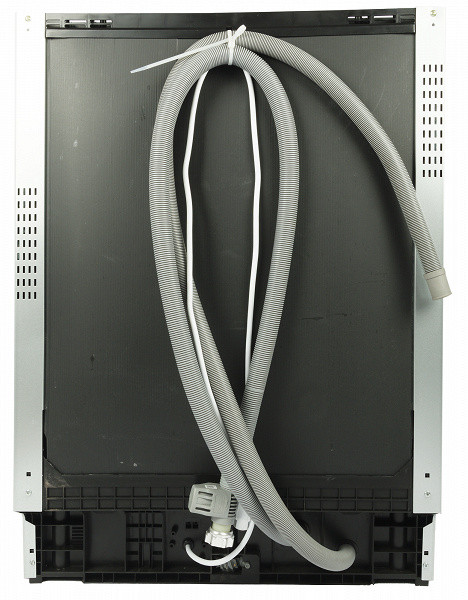
The drain and inlet hoses are already installed on the dishwasher and are secured together with the power cord on the back wall. The inlet hose is equipped with a leakage protection system in case of damage — the AquaStop valve.
Instructions
The dishwasher operating manual is presented as a 34-page A5 brochure on thick white paper with high-quality printing. Numerous illustrations and small print are easy to read.
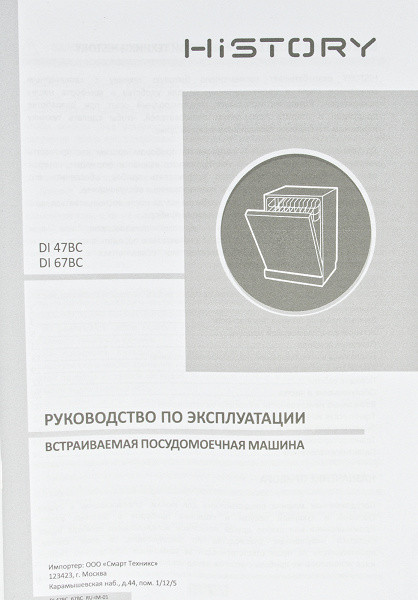
The manual covers two similar models — wide and narrow. It provides detailed instructions on installing the dishwasher, connecting to the water supply and sewerage, as well as operating and maintaining the device.
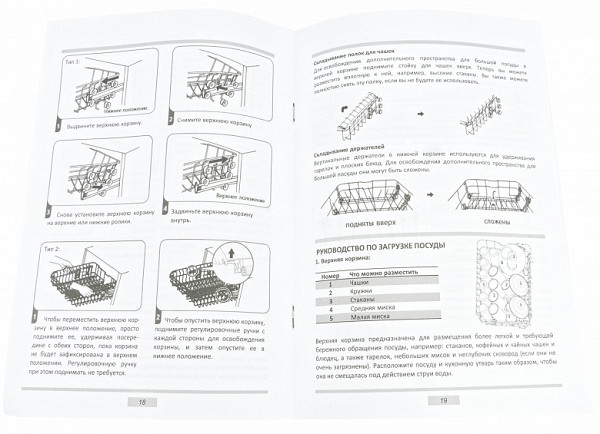
The document ends with a list of error codes that may appear on the control panel and how to fix them, a list of technical specifications and the seller's warranty obligations.
The documentation also includes a guide to installation and a mandatory sticker with information on energy efficiency.
Control
As with all built-in dishwashers, the controls of the History DI 67BC MSS are concentrated on the top edge of the door.
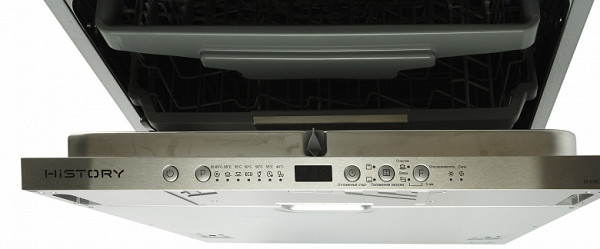
The control panel includes five buttons separated by an LED display:
- The «Power» button turns the dishwasher on and off.
- The «P» button allows you to select a washing program.
Our dishwasher has a total of seven programs.
| Program name | Purpose |
|---|---|
| Auto | Automatic washing of lightly, moderately or heavily soiled dishes |
| Intensive | For washing heavily soiled dishes, including pans and pots with dried-on food residues |
| Standard | For daily washing of moderately soiled dishes: pots, plates, glasses and lightly soiled frying pans |
| Eco | The most economical program for everyday washing of dishes with a medium degree of soiling |
| Delicate | For washing lightly soiled glassware |
| 90 minutes | For quick cleaning of dishes with medium soiling |
| Fast | Quick wash for lightly soiled dishes that do not require drying |
By default, the fourth program («Eco») is activated, and to select the remaining programs, you need to press the «P» sensor in sequence.
The «Delayed Start» function allows you to delay the start of the program for a period of 1 to 24 hours in 1-hour increments.
The «Half Load» function helps save water and energy by placing dirty dishes in only one of the baskets — the upper or lower. In this case, only one sprayer works: the upper or lower one, respectively.
Additional options can be activated by successive presses of the «F» button:
- «Additional Cleaning» is designed for washing heavily soiled dishes that are difficult to clean. This function is available in the "Intensive", "Standard", "Eco", "Delicate" and "90 Minutes" programs.
- «Drying with Door Open» automatically opens the dishwasher door after the cycle is complete, improving the drying of the contents.

The blue LED display shows the remaining or predicted programme time.
The two red LEDs on the right side of the control panel light up when the rinse aid or salt in the corresponding containers runs out.
Operation
The installation and connection of the History DI 67BC MSS dishwasher is similar to the process for other similar devices. First, you need to unpack the device and connect the standard hoses to the water outlet and sewer. The electric plug should be inserted into a grounded outlet that provides the required power; the manufacturer recommends using a separate outlet with an automatic fuse of 10-16 A.
After installing the dishwasher in the kitchen unit, it is necessary to align it horizontally by adjusting the front legs, and adjust the door mechanism springs so that the door opens easily and does not slam shut on its own.
Before starting to use, you should adjust the salt consumption in the softener, checking the water hardness parameters with your local water supply company. To do this, turn on the machine, then no later than 60 seconds later press and hold the «Program» button for at least 5 seconds to activate the setup mode. By successively pressing the same button, set one of the six water hardness levels indicated on the screen: «H1» for very soft water with zero salt consumption and «H6» for very hard water.
The rinse aid consumption is adjusted in a similar way. After activating the setup mode with the «Delayed start» button, select one of the five consumption levels, from «D1» to «D5». To exit the engineering menu and save the settings, press the «Power» button.
The dishwasher offers the following programs:
| Program | Operating time, minutes | Description of the cycle | |
|---|---|---|---|
| 1 | Auto | 85-150 | Pre-wash (45°C) Wash (55–65°C) Rinse 1 Rinse 2 Rinse 3 (50–55°C) Drying |
| 2 | Intensive | 205 | Pre-wash (50°C) Wash (65°C) Rinse 1 Rinse 2 Rinse 3 (60°C) Dry |
| 3 | Standard | 175 | Pre-wash (45°C) Wash (55°C) Rinse 1 Rinse 2 Rinse 3 (60°C) Dry |
| 4 | Eco | 198 | Wash (50°C) Rinse 1 (50°C) Dry |
| 5 | Delicate | 120 | Pre-wash (40°C) Wash (50°C) Rinse 1 Rinse 2 (50°C) Dry |
| 6 | 90 minutes | 90 | Wash (55°C) Rinse 1 Rinse 2 (50°C) Dry |
| 7 | Fast | 30 | Wash (40°C) Rinse 1 (40°C) Rinse 2 (55°C) |
In addition to the standard modes (Eco, Standard, Intensive, Delicate), the dishwasher has two quick programs that vary in duration, water temperature and number of rinse cycles, as well as an automatic mode, where the duration and temperature of the main cycle depend on the degree of contamination of the dishes. Such a set of programs, in our opinion, meets most of the user's everyday needs.
The History DI 67BC MSS dishwasher is equipped with a tank light — a rare but useful function. It makes it easier to load and remove dishes even in dim lighting in the kitchen, helping not to forget small items in the baskets.
The half-load mode allows you to effectively save water and electricity by placing dishes in only one of three baskets: the lower or middle one.
At the end of the work, a few minutes before the end of drying (from 10 to 40 minutes depending on the program), the machine automatically opens the door, which helps remove excess moisture and better dry the dishes. If necessary, this function can be switched off.
This model does not have a floor indicator. The «red beam» projected onto the floor in front of the operating device is useful for fully integrated models with a hidden display, as it signals the end of the last drying cycle. In this case, you can only find out about the end of the program by slightly opening the door, unless the function is switched off.
Care
After each dishwashing cycle, the manufacturer recommends leaving the door slightly open to dry the interior, which helps prevent unpleasant odors.
The door seals should be regularly wiped with a damp soft cloth to remove food residues. It is also important to periodically rinse the filter system elements under running water; using the machine without a filter is not allowed.
The control panel should be wiped with a soft damp cloth, avoiding water getting on the buttons and indicators.
Before a long break in use, it is recommended to run a wash cycle without dishes, then disconnect the machine from the mains, turn off the water supply and leave the device half-open.
Our measurements
Information on energy consumption and water consumption is provided in the documentation. We measured the actual consumption and compared it with the figures specified by the manufacturer.
| Program | Energy consumption, kW h | Water consumption, l | ||
|---|---|---|---|---|
| declared | actual | declared | actual | |
| Auto | 1,050-1,551 | 0.541 | 10.6-15.9 | 9.6 |
| Intensive | 1,651 | 1,075 | 16.5 | 15.2 |
| Standard | 1,451 | 0.862 | 16.5 | 17.2 |
| Eco | 0.849 | 0.681 | 10.0 | 9.5 |
| Delicate | 1,902 | 0.632 | 13.5 | 16.1 |
| 90 minutes | 0.891 | 0,520 | 10.3 | 12.1 |
| Fast | 0.781 | 0.481 | 11.0 | 11.7 |
The rated power consumption values turned out to be overstated: in practice, the dishwasher consumes one and a half times less power than stated by the manufacturer. Water consumption on average corresponds to the declared data.
The measured noise level during machine operation does not exceed 55 dBA. Noise is measured using a sound level meter microphone located at a distance of 1 meter from the operating machine, not built into the kitchen unit. After installation in the kitchen front, the actual noise level will probably be significantly lower.
The maximum power recorded during testing was 1838 W. When switched off, the model consumes about 1 W.
Practice tests
Test operation, of course, includes regular dishwashing. But especially for this class of equipment, we have come up with several interesting tests, which we will tell you about now.
Eco-program and "artificial dirt"
As usual, we took the perfect mud. Everyone needs to read the recipe to understand why it is so sticky and why it is so difficult to wash off.
We left the plates soiled with the mayonnaise and ketchup mixture for a day to dry completely, and then placed them in the bottom basket without much care. The middle basket contained porcelain bowls and saucers with the same mixture, and we placed the dirty cups on the folding shelf. We placed cutlery and kitchen utensils in the top basket, without paying much attention to their placement.
For the test, we used the standard Eco program, which is optimized to save energy and water. The result exceeded expectations: the dishes and cutlery in each basket were washed to a perfect condition, without visible traces of dirt and food residue.
Not a drop of moisture remained on porcelain and metal surfaces. A little condensation remained only on the plastic handles of knives and spatulas — condensation drying usually does not cope with this material.
Result: excellent
Standard program and dried tomato sauce
To test the automatic program, we used three jars: one three-liter and two two-liter. We generously applied ketchup (without mayonnaise) inside the jars and left them to dry for a day.

The jars fit comfortably in the back half of the lower basket on folded holders.
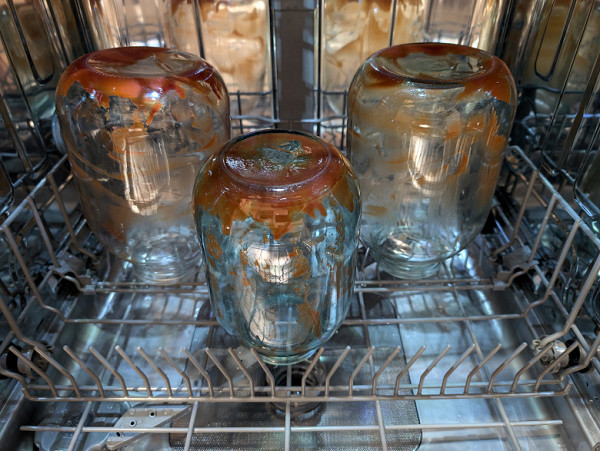
For this experiment, we selected the Standard program, which is designed for daily washing of moderately soiled dishes.

The quality of the wash was pleasing this time too: the jars were washed perfectly, we found no traces of tomato, and the glass was completely dry.
Result: excellent
Wine Glasses and Delicates Washing Scenario
In this test, we stain glass goblets with thick lipstick, simulating the situation after a party. To create the effect that the hosts left for work and returned in the evening, we leave the dishes to dry for 24 hours.

The large 600ml wine glasses were placed in the middle basket with their stems resting on the fold-down shelf. All four glasses fit perfectly and had plenty of space: full-size dishwasher baskets have plenty of room.

For this experiment we chose the «Delicate Wash» scenario.

We were completely satisfied with the quality of washing: there were no traces of wine sediment or greasy lipstick left on the thin glass. However, the quality of drying did not meet expectations: drops of water remained on the glass, which forced us to reduce the rating by one point.
Result: good
Intensive program and heavy pollution
To test the intensive cleaning program, we traditionally cook fatty meat with sour cream sauce in a ceramic dish. Then we put the empty container in the oven for 15 minutes to form a stable crust and smell.
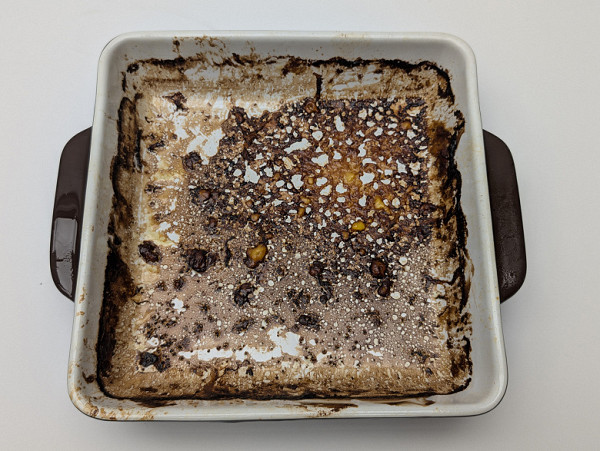
We placed the dishware in the lower basket, folding the dish guides, and selected the intensive wash program.
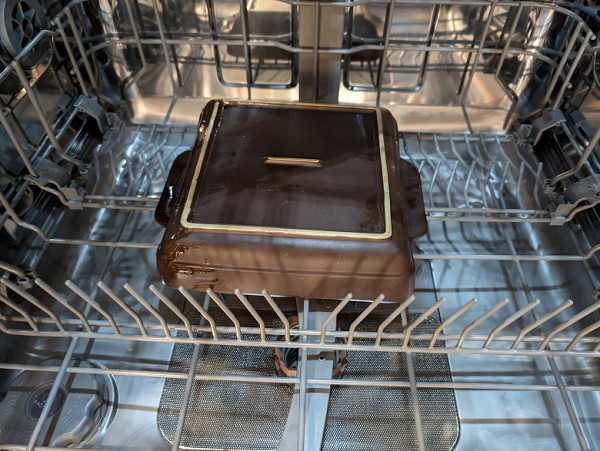
We were completely satisfied with the result: the ceramic vessel was cleaned almost perfectly, with minor traces of burnt fat on the edges. These traces were easily removed after wiping the ceramic with a damp sponge.

We were also satisfied with the drying quality, although a few drops of water could be seen on the concave bottom.
Result: excellent
Conclusions
The History DI 67BC MSS dishwasher has a convenient shelf design, a third basket for cutlery and a variety of built-in programs with useful additional options. We especially liked the half-load and open-door drying functions. We are also pleased with the tank lighting, which makes loading and unloading the device easier.
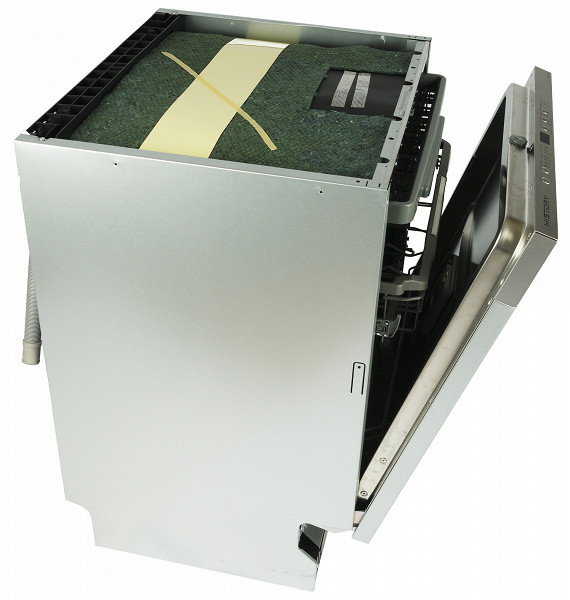
The dishwasher demonstrated excellent results in everyday use and successfully coped with all our standard tests. The only drawback is the lack of a floor indicator of program progress, which would be useful for fully integrated appliances.
Pros:
- good set of built-in programs and additional options
- the presence of a third shelf for cutlery
- effective dishwashing
- drying with the door open
- tank lighting
Cons:
- no floor indicator of program progress («red beam»)

